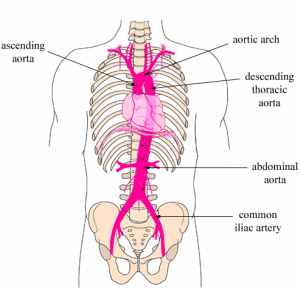

MedFriendly®


Aorta
The aorta is the largest artery of the body. An artery is
a blood vessel that carries blood away from the heart.
The aorta is classified as an elastic artery, meaning
that it is a large artery that contains many elastic
(flexible) layers in the middle of it.
WHERE IS THE AORTA LOCATED?
The aorta arises from the bottom of the left ventricle
of the heart, where it is 3 centimeters wide. The left
ventricle of the heart is an opening in the heart that
sends blood to the aorta. The aorta arches over the
left side of the heart, rises a small distance towards
the neck, and bends to the back left over the root of
the left lung.
FEATURED BOOK: The Human Aorta: Your Super Highway of Life
The aorta then travels down within the chest on the left side of the bones that make up
the spine. It then passes though an opening in the diaphragm (a muscular-fibrous area
that separates the chest and abdomen) and enters an opening in the abdomen. The
aorta then narrows to about 1.75 centimeters in width and ends at the left side of the
body in the lower back (specifically, the area of the fourth lumbar vertebrae, which is a
bone in the lower back). There, the aorta divides to form two other arteries knows as the
right and left common iliac arteries (pictured to the rght). The common iliac arteries go on
to supply blood to the lower limbs, the pelvis, and various body organs.
"Where Medical Information is Easy to Understand"™
The aorta then travels down within the chest on the left side of the
bones that make up the spine. It then passes though an opening in
the diaphragm (a muscular-fibrous area that separates the chest
and abdomen) and enters an opening in the abdomen. The aorta
then narrows to about 1.75 centimeters in width and ends at the left
side of the body in the lower back (specifically, the area of the
fourth lumbar vertebrae, which is a bone in the lower back).
There, the aorta divides to form two other arteries knows as the
right and left common iliac arteries (pictured to the rght). The
common iliac arteries go on to supply blood to the lower limbs, the
pelvis, and various body organs.

WHAT DOES THE AORTA DO?
Being the largest artery in the body, the aorta is the main area by which blood is sent out away from the
heart to the rest of the body. The aorta accomplishes this by splitting up into four areas. The first two
areas are: 1) the ascending aorta, which gives rise to the coronary arteries (blood vessels that supply
blood to the heart); and 2) the aortic arch, which arises from the ascending aorta. Three major arteries
branch off from the ascending aorta: a) the brachiocephalic artery, which supplies blood to the brain and
head, b) the left common carotid artery, which supplies blood to the head and neck, and c) the left
subclavian artery, which supply blood to the spinal cord, bones of the spine, ear, and brain.
When the aorta descends (goes downwards), it is divided into the other two parts of the aorta: 3) the
thoracic portion of the descending aorta, which supplies blood to many areas in the body such as the
ribs, heart stomach, and stomach; 4) the abdominal portion of the aorta, which supplies blood to many
areas of the body such as the ovaries, testicles, kidney, and stomach. These areas are pictured above.
WHAT IS THE ORIGIN OF THE TERM, AORTA?
Aorta comes from the Greek word "aerein" meaning "to raise or to hang." The reason for this is because
the famous philosopher, Aristotle, believed the aorta was the artery from which the heart hangs. The
word "aorta" first appeared in English in 1594. The plural form of aorta is "aortae."














